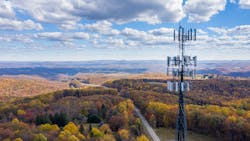Biden’s Infrastructure Plan Gets It Right on Broadband
Our electric utilities power just about everything in our lives, from our smart phones to our homes and, increasingly, our transportation fleet. But more and more, our nation’s electric utilities are becoming vital to one other critical public need—broadband. Right now, hundreds of publicly owned and cooperatively organized electric utilities are providing high-speed, reliable, and affordable broadband services to customers in unserved and underserved locations.
So it is no surprise that policymakers at the state and federal level are pursuing programs that highlight the key roles electric utilities can play in connecting all Americans to broadband connectivity. The White House is touting a $2.25 trillion infrastructure package which not only recognizes the successful broadband networks owned and operated by cooperative and publicly owned utilities, but it also seeks to lift restrictions on other utilities from doing so elsewhere.[1] Lawmakers in Congress had already introduced legislation which would have the same impact.[2]
While the Utilities Technology Council has not taken a position on every piece of the White House infrastructure plan, we believe the policies on broadband will assist in connecting all Americans to the internet. That there even is a Digital Divide is indicative of a market failure—it is costly and takes a tremendous amount of infrastructure to bring broadband to rural and remote locations. Even the nation’s telecommunications industry has acknowledged that federal subsidies are the key to solving the problem.[3]
That’s why electric utilities are key partners in solving the Digital Divide. For one, utilities already have the infrastructure in place in these remote areas, and two, they have the expertise in building fast, highly reliable communications networks for their own purposes. Indeed, nearly every utility in the country operates its own private communications system to operate its infrastructure and keep its crews safe in the field.[4]
Policymakers across the political spectrum have recognized the critical role utilities can play in deploying broadband. These policies are not just happening in Congress, as several states—both republican and democratic—have either recently adopted or are currently debating legislation permitting municipally and cooperatively owned utilities to provide broadband services to their communities. Arkansas[5], in fact, recently finalized legislation lifting restrictions which were prohibiting municipalities from offering broadband, while Washington[6] and West Virginia[7] lawmakers are considering similar bills.
Interestingly, these electric-utility broadband affiliates are able to provide connectivity speeds as fast as 1Gbps, with most customers purchasing speeds between 100 to 500 Mbps, according to an informal survey of UTC cooperative and public power utilities. This is relevant as the federal government debates whether its current definition of broadband of 25/3 Mbps is outdated. While we will leave that discussion for others, our members have told us that when their customers are offered higher connectivity speeds, they buy it.
At UTC, we support any and all policies which promote the utility role in deploying broadband. As the White House recognized, broadband is becoming as essential to our lives as electricity, and it will likely take the same kind of federal approach to ensure that no Americans are left behind.
To that end, we are seeing another trend within the electric utility industry—larger, multi-state investor-owned utilities (IOUs) providing middle-mile broadband services. The majority of Americans are served by IOUs, which are shareholder owned and price-regulated by state regulatory commissions. While IOUs are likely not going to become internet-service providers (ISPs) like some cooperative and public-power utilities, these utilities can still play a major role in bringing broadband service to unserved and underserved areas.
For example, two of the country’s largest IOUs—American Electric Power subsidiary Appalachian Power Company and Dominion Energy—have established pilot programs providing middle-mile broadband connectivity to rural counties in Virginia. As these utilities invest in new technologies aimed at modernizing their own infrastructure, these same technologies—such as fiber—can bring broadband connectivity to unserved and underserved areas. From there, local ISPs or even cooperative utilities can use this connection and serve their own customers, bringing a critical economic lifeline to these communities.
Appalachian Power has a similar project pending in West Virginia, and Dominion Energy has reached a middle-mile agreement with a cooperative utility. Other IOUs involved in middle-mile projects include Alabama Power, Vermont Electric Power Company, and Green Mountain Power. In addition, Louisiana-based Entergy is working with a regional ISP on a smart-metering project which will also provide unserved customers in parts of Mississippi with broadband access.
Additionally, every electric utility in the country—whether IOU, cooperative, or public power—empowers broadband by permitting ISPs and global telecommunications behemoths with steeply discounted, heavily regulated, fees for attaching voice, cable, and internet devices on utility owned poles. The next time you look at the electric distribution pole on your street, you’ll see that it delivers more than electricity. It oftentimes also carries the equipment needed to get connected to the internet as well.
The White House’s infrastructure plan is right to highlight broadband connectivity as a top priority. America’s electric utilities are answering the call to assist in this national effort, and we look forward to working with Congress and the White House to ensure that no Americans are left behind.[1] https://www.whitehouse.gov/briefing-room/statements-releases/2021/03/31/fact-sheet-the-american-jobs-plan/
[2] https://energycommerce.house.gov/sites/democrats.energycommerce.house.gov/files/documents/Section-by-Section%20of%20LIFT%20America.pdf
[3]https://www.ustelecom.org/wp-content/uploads/documents/Rural%20Broadband%20Economics-A%20Review%20of%20Rural%20Subsidies%20%5B1%5D.pdf
[4] https://utc.org/wp-content/uploads/2018/10/About-Utility-Comms-101.pdf
[5] https://muninetworks.org/sites/www.muninetworks.org/files/SB74.pdf
[6] https://app.leg.wa.gov/billsummary?BillNumber=1336&Year=2021&Initiative=false
[7] https://www.wvlegislature.gov/Bill_Status/bills_text.cfm?billdoc=HB2002%20SUB%20ENG2.htm&yr=2021&sesstype=RS&i=2002
About the Author
Sheryl Osiene-Riggs
Utilities Technology Council President and CEO
